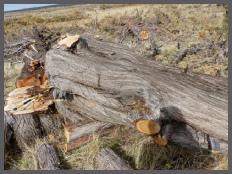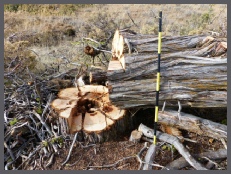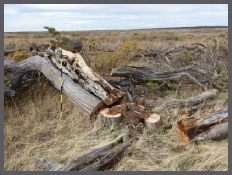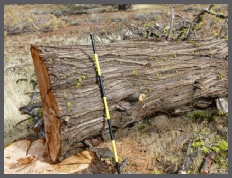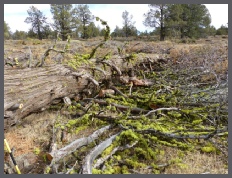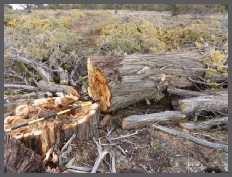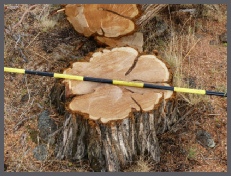Contact Us. Web site contents copyrighted. All rights reserved. Made With Serif WebPlus. Home

Triangle Sage Steppe Restoration Project
Modoc National Forest, Devil’s Garden District
Proposed 2014, Implemented Spring 2016
The measuring stick has six inch increments.
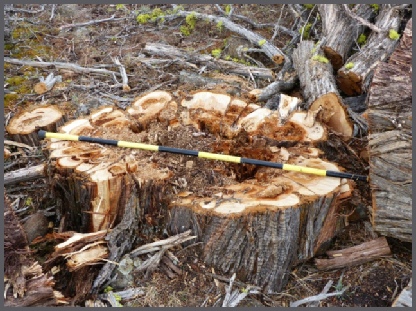
The Triangle Allotment Sage Steppe Restoration Project is another typical juniper removal project for the Modoc National Forest. The only restoration action by the Forest Service is the removal of juniper and as usual this included removal of many “protected” old growth juniper.
The Environmental Assessment (EA) for this project on page 13, Comparison of Alternatives, states: “The proposed action stipulates that juniper with “old growth” characteristics would not be removed.” We submitted our comments concerning the retention of old growth juniper during the public scoping of the Triangle project EA. The Forest Service responded to our comments in Appendix B, page 45, of the Final EA: “All contractor work orders issued will specify that old growth juniper will be left untreated. The project site would be inspected on a regular basis to ensure compliance with these design criteria.” On page 50 the Forest Service responded to another of our comments: “ A pre-project meeting will be scheduled with the contractor to insure that it is understood old growth trees are not to be removed during treatment. Project inspection will be conducted on a regular basis to communicate directly with those doing the actual treatment for education and enforcement of the old growth retention design criteria.”
On page 10 of the EA in section 2.4 Proposed Action, bullet 4, the Forest Service states in bold print: “Old growth juniper would not be treated.” The EA then lists the characteristics for old growth juniper.
On August 26, 2015 we met with the Devil’s Garden District Ranger, the Rangeland Management Specialist and the NEPA specialist on the site of a newly proposed MNF juniper removal project. The Triangle project had not been implemented at this time. During the conversation we volunteered some GPS and photo data we had collected on old growth juniper for a small eight acre area within the Triangle project. This data was gladly accepted by the Forest Service.
November 5, 2016 we visited this eight acre area where we had collected individual tree data back in 2015. We found that the Forest Service had actually used our data and had put blue flags on some, but not all, of the old growth juniper that we had identified. Not one old growth tree with a blue flag was cut down during implementation. However, of the 39 old growth trees we identified, the Forest Service cut down 15 or 38% of these identified old trees. These were obvious old growth juniper with diameters up to 48 inches. We also found nine other obvious old growth trees cut down in this area for which we had not included data. The Forest Service even cut down a younger juniper that had been flagged with archeology tape and also had an aluminum FS Datum tag that was nailed to its trunk in 1955.
For years we have been urging the Forest Service to flag off old juniper stands as out of bounds to contractors in order to preserve the old trees. This is the first time the Forest Service actually flagged some individual trees and, as we found, not one flagged old tree was cut down by the contractor. Unfortunately the Forest Service did not flag all the old trees and many old growth without flags were cut down.
Antelope Plains is another juniper removal project, not implemented yet, where we have collected GPS/Photo data for old growth juniper stands. We have shared one data set with the Forest Service and they have used orange tape to create a boundary around the old growth stand. We have GPS/Photo data for a different old growth juniper stand within the Antelope Plain project area which we have not shared with the Forest service. There are no orange flags around this separate stand of old trees. We will be able compare the final results from these two areas and then make suggestions to the Forest Service based on old growth stands with flags and those without flagged boundaries. Unfortunately, we suspect that old growth juniper will be cut down everywhere there are no flags. If we are lucky, the old growth will be preserved where the Forest Service flagged the old growth trees as out of bounds.
The measuring stick has six inch increments.
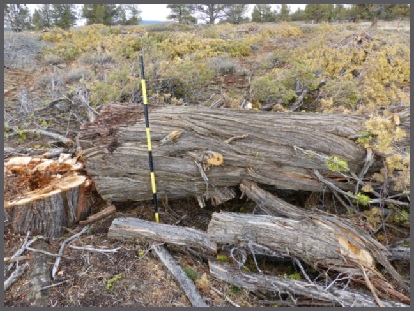


The four images above are all old growth juniper cut down by the Forest Service on the Triangle project. Each old tree had multiple old growth characteristics but were still cut. A juniper should only need one old growth characteristic in order to be preserved.
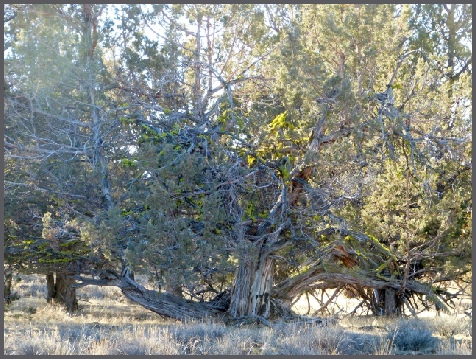
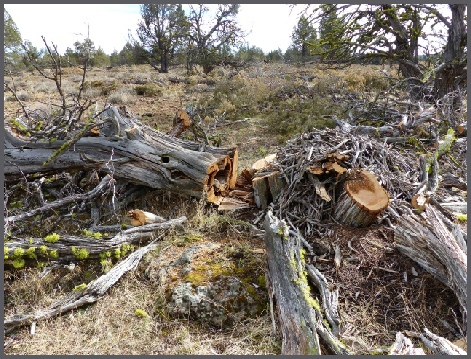
These two images are of the same tree on the Triangle project located by GPS data November 24, 2013 and again November 5, 2016. When the Forest Service cuts down such an obvious old growth juniper during implementation after repeating several times in their EA that old growth juniper will not be treated, the Forest Service looses all credibility as a public land manager. This is not habitat restoration but complete and utter mismanagement of our public resources.
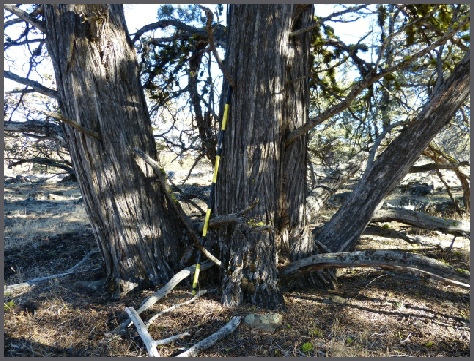
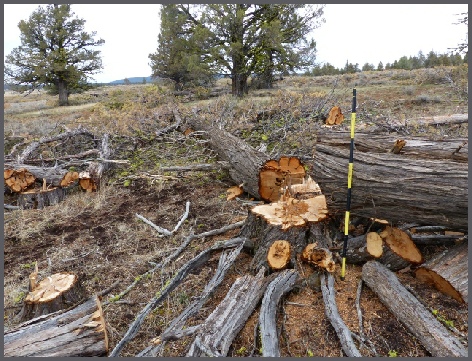
This old juniper has deeply furrowed fibrous bark, an asymmetrical shape and large lower limbs. These are three of the morphological characteristics of an old growth juniper. This project was not a habitat restoration project but strictly a juniper thinning project that destroyed many old growth juniper. The Forest Service project manager completely disregarded the Forest Service EA design criteria that prohibited the cutting of old growth juniper and let this happen.
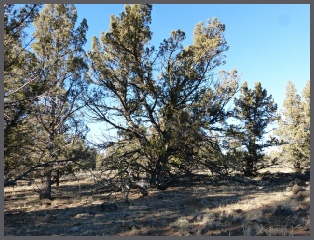
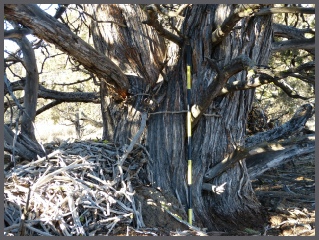
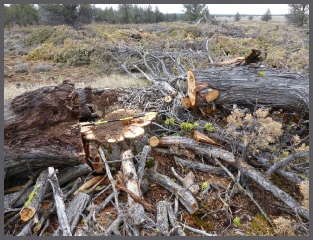
This is another old juniper for which we gave GPS data to the Forest Service. Of the 39 old growth juniper that we documented with data and photos, the Forest Service cut down 15 or 38%. The MNF also cut down nine other old growth juniper in this small eight acre area of the Triangle project.

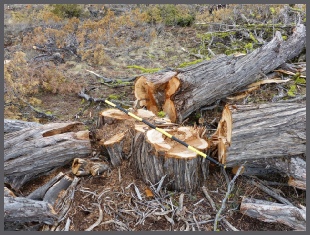
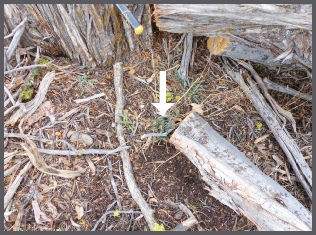
This old growth juniper protected Cusick’s Stickseed (Hackelia cusickii) before it was cut down by the MNF. This plant is included in the CNPS Inventory of Rare and Endangered Plants on list 4.3 (limited distribution) and survives in this area only underneath old growth juniper. Once the protection of the old tree is gone the Cusick’s Stickseed disappears. The arrow in the middle image points to the stickseed. Click on the image for a larger view.
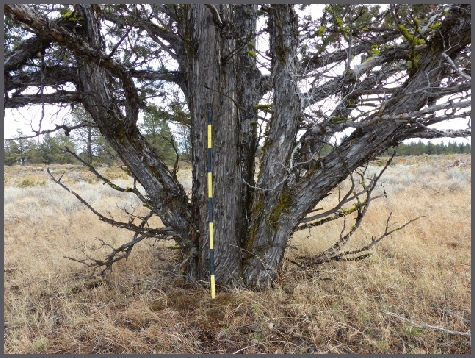
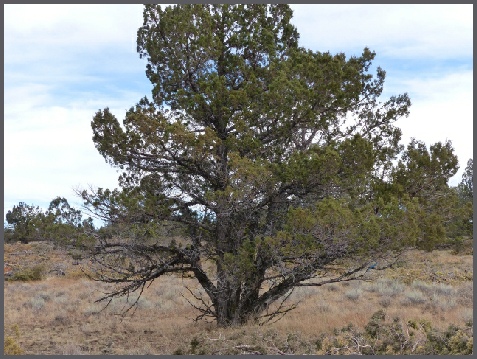
The Forest Service decided to leave this young juniper but decided to cut down the old growth juniper all around it. We have not yet been able to figure out the rationale the Modoc National Forest uses when it decides which trees to cut down and which to leave. The MNF certainly does not use its own published Environmental Assessment or its own project design criteria within the EA. All of the images below are of old growth juniper that were cut down by the MNF during the implementation of the Triangle juniper removal project, all within the small eight acre area.

